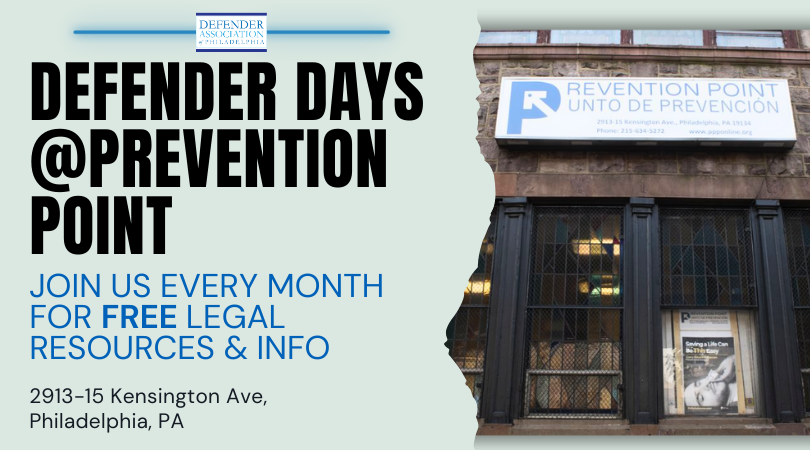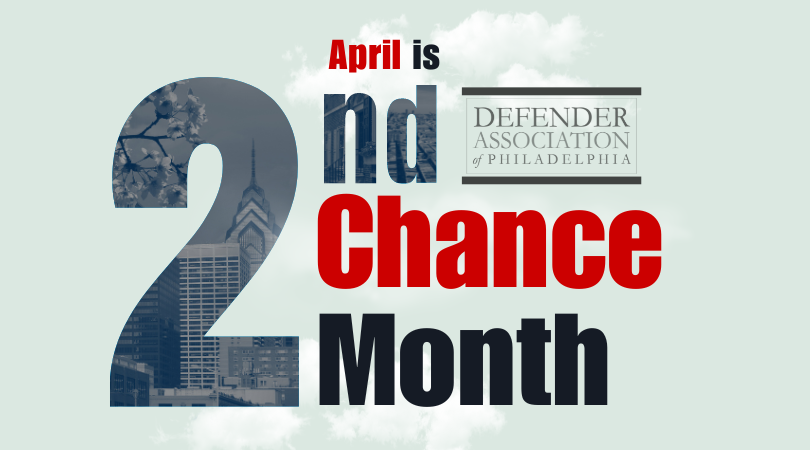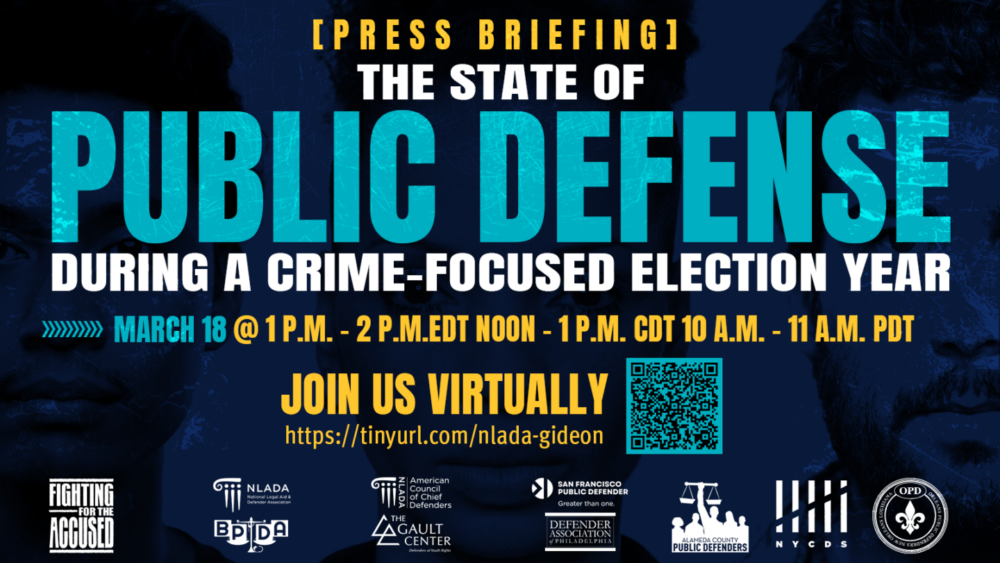Category: Client Support and Services
Statement on the Detention of a Defender Client by ICE
People living in Philadelphia should have the right to due process, regardless of their immigration status.
“Last week, after a Defender Association client’s case was dismissed at a preliminary hearing for lack of evidence, he was detained by law enforcement and transferred to the custody of Immigration and Customs Enforcement (ICE), even though there was no outstanding warrant.
“We’ve raised this matter with the Courts, Philadelphia Police Department, Sheriff’s Office, District Attorney’s Office, Law Department, and City Council, and we are in active communication with immigrant rights organizations across the city.
“The Defender Association has long held that no one should be subjected to immigration enforcement while seeking justice in our courts. What happened last week is a deeply troubling reminder of the real risks faced by non-citizens navigating our justice system. It underscores the urgent need for the city to invest in legal protections for immigrant communities, including the creation of a fully staffed Immigration Unit at the Defender Association, a core priority outlined in our FY26 budget request.
“We remain committed to protecting the rights of all Philadelphians and fighting for a justice system that is fair and safe for everyone, regardless of immigration status.”
# # #
Defender Days at Prevention Point
Each month, the Defender Association teams up with Prevention Point for Defender Days. We offer legal resources, including information on expungements and probation terminations for eligible clients.
Bookmark this page for information on upcoming Defender Days
Join Our Youth Action Board!
Are you 18-23, currently system involved, or have you transitioned out of the system? Do you have something to say? Apply to join our Youth Action Board!
The Youth Action Board (YAB), is a youth-led collective that aims to amplify the voices of older youth (ages 18-23) who have experienced the foster system. Together, our mission is to evoke change and bring awareness to the issues older youth face as they transition out of the system.
The YAB advocates for:
-Raising awareness for youth and connecting them with important services;
-Dismantling systemic injustice and improving legal representation;
-Encouraging services that are culturally aware, trauma informed, and courteous;
-Conflict resolution and effective communication; and
-Promoting leadership, story telling, and uplifting
The YAB will campaign, organize, and advise on issues strictly impacting Older Youth in child-serving systems. This group will guide how to better serve and represent youth in ways that respect their agency.
This is an opportunity for you to be heard and to be at the forefront of making a difference! Apply to be a part of the Youth Action Board!
Fill out the Youth Action Board application here
Download and share the Youth Action Board Flyer
Defender 90th Anniversary Highlights
On April 4, 2024, we’re celebrating 90 years of representing Philly adults and youth with a very special event at the Constitution Center. All are welcome to attend and celebrate along with the Defender’s past and present leaders, and many more elected officials and luminaries who began their careers at the Defender Association.
Help us celebrate 90 years of public defense in Philly, as we look to grow the next generation of Philly Defenders! Click the links below to learn how you can take part in the celebration!
Details, tickets and sponsorship information here
Press Release: Pushing Back on Misleading Crime Narratives
FOR IMMEDIATE RELEASE: March 18, 2024
PRESS CONTACT: Rabiah Alicia Burks, r.burks@nlada.org, (202) 452-0620
Public Defense Chiefs Push Back on Misleading Crime Narratives that Are Driving Policy This Election Year
Speaking at Gideon Day press briefing, chiefs encourage reporters to speak to public defenders for better-informed stories, and discuss ways public defenders promote community safety.
WASHINGTON — Chief public defenders from across the country gathered today for a discussion on the state of public defense during a crime-focused election year. Co-sponsored by the National Legal Aid and Defender Association (NLADA), the panel discussion commemorated Gideon Day, the anniversary of the U.S. Supreme Court’s unanimous decision in Gideon v. Wainwright, which recognizes the constitutional right to public defense for people who cannot afford counsel. A recording of the event can be found here, and a fact sheet/resource guide for reporters is available here.
“Public defender offices across the country are wholly under-resourced, while prosecutors and law enforcement are funded at several times the rate, and this funding discrepancy leads to greater disparities and injustices within the legal system,” said April Frazier Camara, president and CEO of NLADA. “Misleading narratives on crime and safety are fueling these policy decisions. Public defenders are joining forces to fight back against these fear-based tactics and to combat these practices.”
The discussion was moderated by Civil Rights Corps Founder Alec Karakatsanis, a civil rights lawyer and former public defender who has written extensively about “copaganda,” or the manipulation of media by police and prosecutors.
“Public defenders are dedicated to safe communities, and their voices should not go unheard in the national conversation about crime and community safety,” said Karakatsanis. “The extraordinary focus by the media on low-level-crimes reported by police has the effect of manipulating what all of us think and feel are the most urgent problems in our society. It distracts us from the greatest dangers that we face and obscures safety solutions right in front of our eyes. Public defenders can be an invaluable counterbalance to that.”
“Providing indigent individuals with fierce representation in court itself fosters safer communities—by guarding against wrongful convictions and by advocating against incarceration, which is incredibly destabilizing for families and communities,” said San Francisco elected Public Defender Mano Raju. “Our office also provides services that address the root causes of interactions with the criminal system, such as our MAGIC youth programs, our College Pathway Project, which helps formerly incarcerated people go to college and our End the Cycle program, which connects newly arrested people to services.”
Many reporters accept without question the information and crime statistics that police and prosecutors give them, and in turn, their stories are used to bolster policy decisions that benefit law enforcement and drive incarceration. Journalists do a disservice to their readers when their stories are more about feelings than facts, according to the panel.
“We have seen this play out in New York State, where the Governor has rolled back our historic bail reform law on multiple occasions,” said New York County Defender Services Executive Director Stan Germán. “Politicians have succumbed to a fear-mongering campaign launched by proponents of mass incarceration rather than focus on the data analysis which clearly demonstrated the success of a bail law that reduced the racial and wealth disparities in our criminal legal system.”
Funding is an ongoing struggle for public defender offices in large cities as well as rural areas, despite the fact that basic fairness should dictate that prosecutors and defenders receive equal funding.
“In most states, funding for DAs is two to one compared to public defenders, dollar for dollar,” said Alameda County Chief Defender Brendon Woods. “That’s not a fair fight. Another significant factor is the work police departments do in support of the prosecution, essentially providing a free investigatory wing to every prosecutor’s office in the state. If you fund systems that incarcerate people, more incarceration will result. And incarceration drains public resources away from solutions that address the root causes of crime like housing, jobs, and education.”
“One of our biggest challenges is retaining experienced attorneys, who often leave public defense for better-paying jobs in other sectors. If we had pay parity with other legal offices, we’d be able to keep more veteran lawyers, which means better representation to our clients,” said Defender Association of Philadelphia Chief Defender Keisha Hudson. “I think public defenders have tremendous value to the media because we have the insight and data to share the full story of our clients—not just as suspects, but as full human beings.”
“In rural communities, recruitment is challenging due to vast legal deserts. A shortage of lawyers makes workloads for existing public defenders extremely high,” said Iowa State Public Defender Jeff Wright. “We have difficulty competing with the salaries prosecutors and other legal professions are able to offer.”
With greater funding parity, public defender offices are better able to engage in community outreach and to expand programs that prevent people from being funneled into the system in the first place, said Orleans Public Defenders Director of Community Outreach and Lead Organizer Robert Jones.
“Our clients are the community, so we need to be part of that,” said Jones, who is formerly incarcerated. “Community members need to see PDs everywhere. Our office partners with community organizations to assist people when they are in the criminal legal system, and moreover to keep them from having contact with the system.”
This press briefing was sponsored by the NLADA, the American Council of Chief Defenders, the Black Public Defender Association, the Gault Center, San Francisco Public Defender’s Office, Defender Association of Philadelphia, the Alameda County Public Defender’s Office, Orleans Public Defender’s Office, and New York County Defender Services. This event is part of NLADA’s ongoing initiative, “Fighting for the AccUSed: The Public Defender Campaign for Safe, Secure Communities.” The Fighting for the AccUSed campaign is changing perceptions about public defenders in communities and the press. It also seeks to build public support for the passage of the federal EQUAL Defense Act (HR 3758) and the Quality Defense Act (S.850), and urges the Biden Administration to support other federal, state, and local efforts to fund public defense.
Public defenders are integral parts of the communities they serve and include social workers, investigators, community engagement professionals, and lawyers. Nationwide, about 80 percent of individuals who are accused of crimes in the legal system are represented by a public defender.
The National Legal Aid & Defender Association (NLADA), founded in 1911, is America’s oldest and largest nonprofit association devoted to excellence in the delivery of legal services to those who cannot afford counsel. NLADA has pioneered access to justice at the national, state and local levels, playing a leadership role in the creation of public defender systems and other important institutions from The Sentencing Project to the Legal Services Corporation. A leader in the development of national standards for civil legal aid and public defense, NLADA also provides advocacy, training, and technical assistance for equal justice advocates across the country.
###



















